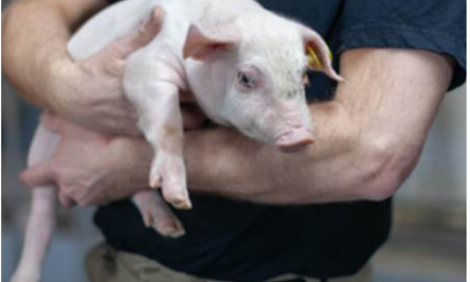



Chile Livestock and Products Annual - September 2005
By USDA, Foreign Agricultural Service - This article provides the pork industry data from the USDA FAS Livestock and Products Annual 2005 report for Chile. A link to the full report is also provided. The full report includes all the tabular data which we have omitted from this article.Report Highlights:
As a result of a strong export demand the largest Chilean pork producers are expanding production by increasing the number of sows. Production then is expected to expand an estimated 10 percent in 2005 and another 14 percent in 2006. Imports also are expected to grow, as exports of pork are likely to outgrow production expansions.
Executive Summary
Chile’s pork industry has based its development on the geographic isolation that has been fundamental to keep an animal disease free environment. Economic stability, along with an open market strategy, have encouraged investments that have had a positive effect on the quantity and quality of production. There is a strong focus on controlling the production process to meet buyer specifications. Pork production has grown extraordinarily during the last decade, at a rate of slightly less than 9 percent yearly. This production expansion is mainly due to increases in efficiency and the transfer of the low grain prices (the main input in swine production) to the consumer, stimulating pork meat consumption.
Production General
Chile’s economic stability and expansion has spurred a continuous increase in meat
consumption over the last decade. An average annual GDP growth rate of over 6 percent
during the last 18 years and per capita income that has increased three times has positioned
Chile as one of the fastest growing economies in the western hemisphere.
As a result meat consumption and production has expanded significantly. The most
impressive growth has occurred in poultry. Chile’s poultry industry has been aided by strong
consumption and on meeting salmonella certification requirements that have kept imports
out. Poultry exports also have grown significantly in the last 10 years. Per capita
consumption has grown from 22 Kg in 1995 to 32 Kg in 2004. In the early 1990’s, the
production that could not be sold in the export market was sold at very competitive prices on
the domestic market, thus cutting into the beef and pork sales.
Beef consumption also has increased but production has not kept pace with rising utilization.
Consequently, Chile has become a significant beef importer. The MERCOSUR member
countries currently are the main suppliers of beef in Chile.
Pork production and consumption also has been increasing steadily for the last decade. Per
capita consumption has increased from 12 Kg in 1995 to 18.5 Kg in 2004. Exports also have
grown since 1995. The latest statistics show that Chile possesses a total population of 2.3
million pigs up from 1.5 million in 1995.
Pork Production
Chile’s pork production has expanded tremendously during the last two decades, from 66
thousand metric tons in 1985 to 372 thousand metric tons in 2004, an average yearly
expansion of over 20%. Its production expansion and efficiency is a result of a privileged
sanitary environment with favorable climatic conditions.
In Chile, the pork industry is highly concentrated and vertically integrated. The Pork
Producers Association only has 40 members out of 140 producers, but these members
produce 92% of the total domestic production. Almost 75 percent of Chile’s pork production
is concentrated among 5 large pork packers, of which Agrosuper accounts for 65 percent of
total production, followed by Friosa at 15 percent and Valledor accounting for 8 percent.
The largest five producers, members of the Association, are vertically integrated. Vertical
integration has enabled producers to maintain a strict level of product traceability throughout
the process and ensuring product safety, quality and reliability from the production site to the
final consumer. Large investments to incorporate state-of-the-art technology that strengthen
sanitary and production efficiency levels, as well as an aggressive campaign to expand
export markets through the implementation of free trade agreements, are the main factors
that explain the Chilean pork industry’s success. Only an estimated 3 percent of total pork
production comes from the so-called non-industrial operations.
Close to 97 percent of the pork producers are located in two Regions, Region VI (Rancagua)
with almost 68 percent of total production and the Metropolitan Region (Santiago) where 29
percent is produced. Agrosuper’s main operation is concentrated in Region VI with 75% of
the total number of pigs.
Industry expects pork production to increase by 10 percent in 2005, because domestic and
export demand are still expanding. Another 14 percent expansion is projected for 2006.
Industry sources believe increased feed costs (higher prices for corn and soybeans) have
affected production in Europe and Brazil. However, demand for pork and pork products in
Asia have been growing as a result of avian influenza. Increases in production in Chile will
be due to an increase in the number of sows maintained by the largest operations. As a
result of increased economies of scale, production costs are expected to fall, which will allow
these producers to export part of this production expansion. Additionally, since they are
integrated vertically, these companies can transfer their cost efficiencies into the price of the
final product, thus stimulating consumption of certain cuts by offering especially competitive
prices.
Consumption
Domestic pork consumption has expanded over 220 percent from 1986 to 2004. Per capita consumption grew from 6.1 Kg in 1986 to 19 Kg in 2004. Additionally its share of total meat consumption in Chile grew from 21 percent in 1986 to 26 percent in 2004. Leaner pork meat, an extensive and aggressive generic marketing campaign, lower prices and increased disposable income are many of the reasons for the significant increase in domestic consumption during the last 20 years. The industry expects domestic pork consumption to reach 22 kilos per capita in year 2010.
Trade: Exports
Chilean pork exports have grown significantly during the last decade, from 2,755 MT in 1995
to over 102,000 MT in 2004, an average annual increase of over 40 percent. The main
destinations for Chilean pork are Japan, South Korea, Mexico and EU member countries.
Industry officials indicate special trade agreements and the higher sanitary conditions for the
pork production are Chile’s main comparative advantage in gaining market access. Chile is
free of the ma in diseases that affect pig production and the strict regulatory controls and
sanitary restrictions carried out by the Agricultural and Livestock Service (SAG) throughout
the production chain, provide a national sanitary framework that prevents the introduction of
diseases, which has allowed Chile to access many different markets.
Until recently the Pork Industry’s main objective was to satisfy domestic demand. Realizing
the good quality of their product and supported by Chile’s open market and export promotion
policies, the industry has turned its attention to the export markets. Exports are forecast to
reach 500 million dollars by 2010 from a base of $322 mil in 2005.
Imports
Industry sources have report that pork imports currently are insignificant, but will most
probably grow in the coming years, as domestic and export demand outstrips production.
The opening of the US market for Chilean pork is expected to contribute to increase Chilean
exports. This will most probably create a larger deficit for the Chilean sausage industry,
which is not vertically integrated, i.e. they do not produce swine and/or own a
slaughterhouse. The sausage industry needs a constant supply of pork imports. As a result
of increased c prices during the last 4 years for domestic input, the processing industry is
increasingly turning towards imports to assure a constant supply. Currently, only certain
cuts are imported (boneless and bellies), as these products are destined for the processing
industry (sausage). Canada has been the main supplier of pork for the sausage industry.
But new market access for US pork products is expected to replace some Canadian imports.
Like Canadian product, US product can now enter duty free.
An industry source indicated that imports would be much larger if price were the only factor
to consider in an import transaction. However since the export market is so important,
imported ingredients must comply with highest sanitary conditions. Pork product imports
can only come from countries that have similar or better sanitary conditions than Chile.
Further Information
To read the full report please click here (PDF format)
Source: USDA, Foreign Agricultural Service - Annual Livestock and Products Report - September 2005








